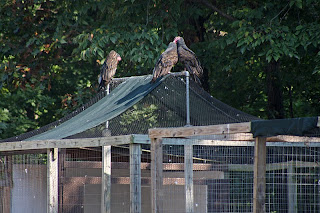World Bird Sanctuary was recently named the best place to see wildlife in Missouri by USA Today stating that we have “the world’s largest collection of raptor species.”
Wild Turkey Vultures hoping to scavenge a meal from our resident vultures
While our captive raptors awe and amaze on a daily basis, we also get a very large contingent of wild birds that visit. Every morning you can see turkey vultures circling over the Display Line, hoping to scavenge a meal from the keepers who feed our birds. Our Bird Banding Team routinely bands the songbirds that flock to our feeders in the summer. And sometimes, we even get wild bald eagles checking out the facilities. Usually they come to see if they can grab a meal in the morning after the keepers have fed the birds on our public Display Line. But one juvenile this summer wasn’t looking for a meal—he was looking for a bath.
I had almost finished lunch one Saturday when one of my junior volunteers came running into the kitchen. “Roger says to tell you that there’s a wild bald eagle taking a bath in the weathering area (a weathering area is a place where we tether our education birds for display and so they can get sun and rain),” she told me in an excited tone. Every head in the kitchen immediately turned to look at her, and our chairs scraped back in unison as we rushed to see the spectacle.
In our Behind the Scenes area, we have a weathering area set aside for some of our larger eagles. This is where Lewis and Clark, the eagles that fly at Busch Stadium, as well as Thor, our Steller’s Sea Eagle, spend their days, along with a few other birds. This weathering area is enclosed on all four sides by welded wire, but has an open top that is almost completely covered with a shade cloth during the summer.
This wild juvenile Bald Eagle dropped in for a bath
Somehow, a juvenile bald eagle had found his way into the weathering area, and was taking a rather large and splashy bath right in Lewis’s water bowl. The older eagles were all staring at this youngster, as though they were shocked by the audacity of this youngster invading their territory. The juvenile seemed unafraid of his elders, but got spooked when the interns, the volunteers and I cautiously approached the weathering area. He jumped out of the bowl, and instead of flying up and out of the enclosure, tried to exit out the side. Unfortunately, he encountered the welded wire. Try as he might to push through the wire, he couldn’t get through to freedom on the other side. At this point, Roger Wallace, our lead eagle trainer, and I stepped in.
Roger got a pair of heavy gloves, just in case, and I started to herd our visitor around the edge of the enclosure and towards the door. He stayed out of reach of our birds, who had started voicing their displeasure at the presence of the intruder. The juvenile stopped about a foot from the door (which was wide open, I might add). Roger took one step towards him, hoping he would fly through… but he bypassed the door and got himself trapped in another corner. Roger was able to capture him (wearing the gloves to protect himself from the eagle’s talons) and brought him outside the weathering area.
Just as we were about to release him, Roger stopped, and decided that we should put a band on his leg, so that he would be identifiable if he were found or spotted again. We gathered the necessary equipment—the band, a pop-rivet gun, a scale, calipers and a large ruler.
At the last second we also found an eagle-sized hood, which goes over a bird’s head and eyes and serves to calm it down during certain situations in falconry or medical treatment. I took the bird from Roger and held him in a restraining position—the bird’s back to my front, wings tucked into his sides, while I held his legs out.
Vital measurements are taken in case he is ever captured again
We put the hood over his eyes to keep him calm, and we took several different measurements so our Bird Banding Team could have a record of the bird—the size of the beak and the hallux (the toe facing backwards), the length of the wings and tail, and the weight of the bird (he came in at a whopping eight pounds, which is a good size for a bird who had only hatched this year). After the measurements had been written down, we encircled one ankle with a metal bird band and affixed it with the pop-rivet gun.Then we took a walk down the road and near the railroad tracks, not a thousand feet from the Meramec River, and there, we took off the hood and threw him up into the air. He flew with ease, down the railroad tracks and into the trees on the edge of the river.
It was refreshing, knowing that not all of the birds we release here at WBS have suffered an injury. Sometimes, all a bird needs is a little help getting on its way.











No comments:
Post a Comment